
|
Nile Whiteway
|
|
???
|
??? GLS
|
???
|
Post Top
|
No Gear
|
1928 Advert
|
|
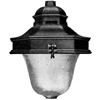
|
Caledon
These utilize two-way non-axial Holophane refractors equipped with 300W lamps, each reflector giving
two beams at 120°. Lanterns are also equipped with the Wardle patent vibration-proof lampholder.
|
|
???
|
??? GLS
|
???
|
Top Entry
|
No Gear
|
1928 Journal
|
|

|
Liverpool
Lantern modified in 1937 to accomodate the new "Metrovick" horizontal Mercury lamps which don't
require the use of a magnetic arc deflector. (They are being described as "new" in 1937.) Has a definite cut-off at approximately 75°. Extensively used
in Lancashire by 1938.
|
|
???
|
250-400W MA/H
|
GES
|
Top Entry
|
No Gear
|
1937 Advert
1937 Programme
1937 Journal
1938 Journal
1938 Advert
|
|
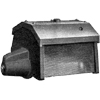
|
|

|
aldwych (originally dome refractor lantern)
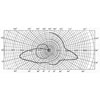 For Group B lighting. A top entry lantern having a one-piece body of
cast-iron, with a hinged vitreous enamelled pressed steel reflector, which supports
a clear glass weather-excluding bowl. A 6" diameter one-piece dome refractor is secured to
an internal reflector by means of three spring loaded hooks. Three types of
refractor bowl are available: two-way axial, two-way non-axial and
symmetrical light distributions.
One of the important post-war lanterns. An external adjuster head on the reflector canopy provides
for lamp focusing.
For Group B lighting. A top entry lantern having a one-piece body of
cast-iron, with a hinged vitreous enamelled pressed steel reflector, which supports
a clear glass weather-excluding bowl. A 6" diameter one-piece dome refractor is secured to
an internal reflector by means of three spring loaded hooks. Three types of
refractor bowl are available: two-way axial, two-way non-axial and
symmetrical light distributions.
One of the important post-war lanterns. An external adjuster head on the reflector canopy provides
for lamp focusing.
This top-entry lantern has a one-piece body of cast-iron with a hinged vitreous-enamelled pressed-steel reflector which supports
a clear glass (weather-excluding) bowl. An external adjuster head on the reflector canopy provides for lamp focusing. The
six-inch diameter one-piece refractor is secured to an internal reflector by means of three spring-loaded hooks. Three types of
refractor are available giving respectively two-way axial, two-way non-axial and symmetrical light distribution. This lantern
accommodates (a) a 100-watt or 200-watt Cosmos Metal-filament lamp; or (b) an 80-watt or 125-watt Metrovick Mercury Dischage lamp.
Either a B.C. (2-pin or 3-pin) or an E.S. lampholder is supplied with the lantern.
|
|
???
|
100-200W GLS
80-125W MB/U
|
BC
3BC
ES
|
Top Entry
|
No Gear
|
1937 Advert
1945 Advert
1945 Journal
1945 Programme
1947 Book
1951 Book
|
|
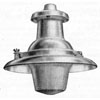
|
ealing
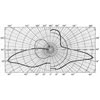 Introduced in 1938. For Group B lighting. Top-entry bowl refractor lantern. Has an easily removable
cast-iron canopy, and a body of stoud sheet copper. Both inner and outer reflectors
are of vitreous enamelled steel. The one-piece bowl refractor gives a two-way
non-axial distribution but alternatively a bowl providing a symmetric
distribution can be supplied. One of the important post-war lanterns. The outer reflector carries the
bowl and has a hook hinge that permits quick removal for cleaning and for easy access to the lamp.
The standard pattern is known as "non-ventilated dust-proof." Alternative lamp-holder positions are provided.
The one-piece bowl refractor gives 2-way non-axial distribution but a symmetric distribution bowl can be
supplied. Any of the following
lamps can be used: (a) 80-watt or 125-watt Metrovick Mercury Discharge; or (b) 100-watt or 200-watt Cosmos Metal-filament
Introduced in 1938. For Group B lighting. Top-entry bowl refractor lantern. Has an easily removable
cast-iron canopy, and a body of stoud sheet copper. Both inner and outer reflectors
are of vitreous enamelled steel. The one-piece bowl refractor gives a two-way
non-axial distribution but alternatively a bowl providing a symmetric
distribution can be supplied. One of the important post-war lanterns. The outer reflector carries the
bowl and has a hook hinge that permits quick removal for cleaning and for easy access to the lamp.
The standard pattern is known as "non-ventilated dust-proof." Alternative lamp-holder positions are provided.
The one-piece bowl refractor gives 2-way non-axial distribution but a symmetric distribution bowl can be
supplied. Any of the following
lamps can be used: (a) 80-watt or 125-watt Metrovick Mercury Discharge; or (b) 100-watt or 200-watt Cosmos Metal-filament
|
|
???
|
100-200W GLS
80-125W MB/U
|
BC
3BC
|
Top Entry
|
No Gear
|
1938 Journal
1938 Programme
1945 Advert
1945 Journal
1945 Programme
1946 Programme
1947 Book
1951 Book
|
|

|
urmston
 For Group A lighting. Introduced in 1938, this was the company's latest lantern for 250-400W mercury lamps with a single-piece
refractor bowl. Uses a side-entry lantern of light and robust construction, being especially
suitable for mounting on trolley bus poles and other locations where severe conditions are found. One
of the important post-war lanterns. Has a neatly disposed arrangement
for side entry mounting. The body
consists of a weather resisting aluminium casting, to which the bowl refractor
is fixed by means of a stout carrier ring, fitted with a hook hinge and three wing-nuts.
The one-piece canopy is a copper
spinning, and the lantern has an inner reflector of vitreous enamelled
steel. The refractor bowl is similar to that of the Gower lantern and can be supplied with three options:
2-way axial, 2-way non-axial and symmetrical distributions.
For Group A lighting. Introduced in 1938, this was the company's latest lantern for 250-400W mercury lamps with a single-piece
refractor bowl. Uses a side-entry lantern of light and robust construction, being especially
suitable for mounting on trolley bus poles and other locations where severe conditions are found. One
of the important post-war lanterns. Has a neatly disposed arrangement
for side entry mounting. The body
consists of a weather resisting aluminium casting, to which the bowl refractor
is fixed by means of a stout carrier ring, fitted with a hook hinge and three wing-nuts.
The one-piece canopy is a copper
spinning, and the lantern has an inner reflector of vitreous enamelled
steel. The refractor bowl is similar to that of the Gower lantern and can be supplied with three options:
2-way axial, 2-way non-axial and symmetrical distributions.
|
|
???
|
300-500W GLS
80-125W MBF/U
250-400W MA/V
|
ES
3BC
GEC
|
Side Entry
|
No Gear
|
1938 Journal
1938 Programme
1939 Programme
1945 Journal
1945 Programme
1946 Programme
1947 Book
1951 Book
|
|

|
poplar
Believed to be the
ELECO Goldenray.
Introduced in 1938, the first low pressure sodium lantern developed by the company as the company have
just entered the sodium lamp field. Uses refractor plates. For Group A and B lighting. Available in three
different lengths to take the
45W, 60W, 80W or 140W SO/H lamp. It has a cast-iron top and cast-aluminium
end plates, the refractor plates being supported in stout copper channels.
Each of the prismatic glass plates has both vertical and horizontal prisms to ensure maximum
utilisation of the light emitted by the lamp. The standard design embodies one-piece plates;
but two-piece plates giving a smooth surface both outside and inside can be supplied.
The standard distribution is
at 160° in plan, although a distribution of 180°
can be supplied. One of the important post-war lanterns.
|
|
???
|
45W SO/H
60W SO/H
85W SO/H
140W SO/H
|
BC
|
Top Entry
|
No Gear
|
1938 Journal
1938 Programme
1945 Journal
1945 Programme
1946 Programme
1947 Book
1947 Programme
1947 Journal
1951 Book
|
|
|
|
???
Introduced in 1938, an entirely new design of lantern for horizontal 250-400W lamps, having single piece
refractor plates. Could be the Trafford (see below) but the description mentions "plates" and not a "bowl". Also
the Trafford is described as "new" in 1939.
|
|
???
|
250-400W MA/H
|
GES
|
Top Entry
|
No Gear
|
1938 Journal
1938 Programme
|
|

|
trafford (original design)
Described as a new type of street lighting lantern for use with
horizontally burning discharge lamps in 1939. An entirely new lantern of exclusive
design for Mercury Vapour lamps burning horizontally, it's the first to employ a
specially designed horizontal refractor bowl. With magnetic control the output is
18000 lumens but without its 16400 lumens. The refractor bowl with its high
efficiency and accurate control marks a new era in lantern design.
|
|
SMI
|
250-400W MA/H
|
GES
|
Side Entry
|
No Gear
|
1939 Advert
1939 Programme
|
|

|
gower (original design)
For Group A lighting. Bowl refractor lantern having a heavy gauge sheet copper
body rivetted to a cast-iron canopy embodying a cool wiring chamber.
The one-piece bowl refractor is easily cleaned and can be supplied
with either 2-way axial, 2-way non-axial or symmetric distribution. Probably named after Gower Street, London
where the first installation was installed.
|
|
S18
|
300-500W GLS
80-125W MBF/U
250-400W MA/V
|
ES
3BC
GEC
|
Top Entry
|
No Gear
|
1939 Advert
|
|
|

|
starlite lantern
For wartime use. To British Standard Specification BS/ARP 37. Provides an
effective wide spread of low value illumination. Has a permanent optical system
which can't be disturbed. The Starlight street lighting fitting is nearly constructed with a light cast
canopy and bottom disc,
while the body is a single pressing. Two brass thumb screws permit easy lamp replacement. Dust and small insects
are prevented from clogging the fine mesh inside by means of a small glass cylinder held between two rubber
sponge gaskets. Electrical and mechanical adaptors of all types are available, including adaptors to permit fixing
to existing lanterns. Weatherproof cast canopies drilled and tapped for conduit entry can also be supplied.
|
|
Starlite
|
15W GLS
|
BC
|
Top Entry
|
No Gear
|
1940 Advert
1940 Journal
|
|
|
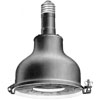
|
starlight
Originally made by Ferranti Limited. For war-time use. Built to specifications in BS/APR 37. Units available for 25W and 15W
lamps in 20' and 15' mountings. 15W only for 10' mounting. Units made suitable for attaching to various
forms of flexible and rigid connectors. Street lighting is by the 'beacon effect' so a line
of fittings can be discerned up to 10 or 12 points ahead. No tools required to dissemble - simply
need to undo the captive thumb screw. No glass, mesh or gauze.
|
|
Starlight
|
15W GLS
25W GLS
|
BC
|
Top Entry
|
No Gear
|
1940 Advert
|
|
|
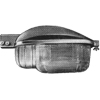
|
trafford (new design)

 For Group A lighting. The first considering when designed was not the question of cost, but rather the
development of a simple optical system of entirely new design planned to give optimum efficiency
with low overall cost of the installation. An efficient optical system must be designed in such a manner that
the entire output of the lamp in all directions is utilised to the best advantage; for this reason,
preliminary designs of lanterns having blank ends or opal plates at the ends were all rejected and a prismatic
glass bowl was decided on. The principle of graduated diminution of candle power at angles approaching the
horizontal is now universally recognised as the main factor in the reduction of glare; this is achieved by the
adoption of narrow prisms to control the light in these angles and by avoiding the use of reflection. The reflector
is used only to "fill in" the polar curve at the lower angles.
Used with lamps burning horizontally and possesses the advantages of
close control of light in the vertical plane to ensure an optimum distribution
for maximum road brightness, combined with the avoidance of glare. At the same
time a broad controlled distribution in plan is simply effected. Has a controlled (or semi)
cut-off. The lantern is a one-piece casting forming the canopy and
bracket entry boss, and a detachable hook hinge, which supports the bowl.
When the lantern is opened the bowl remains securely fixed to the ring.
The lantern incorporates a magnetic device for controlling the arc. One of the important post-war lanterns.
The mechanical construction is exceedingly robust and consists of a one-piece casting forming the canopy and
bracket entry boss, and a detachable "hook-hinge" ring, which supports the bowl. When the lantern is opened
the bowl remains sercurely fixed to the ring whilst the whole i.e. ring and bowl, may be easily lifted from
the hinge for cleaning or replacement. The bowl is made of special heat-resisting glass which remains unaffected
even when chilled water is sprayed on the bowl. Attention is paid to ease of erection and maintenance, and the bracket
connection is of the slide-on type secured by draw bolts; an easy-wiring arrangement is provided. Glassware
cleaning is easy as the hook hinge, and an aperature in the bowl supporting ring, enables the glassware to be
removed and lowered to the ground where it can be cleaned. By this means maintenance can be rapidly and
efficiently carried out.
For Group A lighting. The first considering when designed was not the question of cost, but rather the
development of a simple optical system of entirely new design planned to give optimum efficiency
with low overall cost of the installation. An efficient optical system must be designed in such a manner that
the entire output of the lamp in all directions is utilised to the best advantage; for this reason,
preliminary designs of lanterns having blank ends or opal plates at the ends were all rejected and a prismatic
glass bowl was decided on. The principle of graduated diminution of candle power at angles approaching the
horizontal is now universally recognised as the main factor in the reduction of glare; this is achieved by the
adoption of narrow prisms to control the light in these angles and by avoiding the use of reflection. The reflector
is used only to "fill in" the polar curve at the lower angles.
Used with lamps burning horizontally and possesses the advantages of
close control of light in the vertical plane to ensure an optimum distribution
for maximum road brightness, combined with the avoidance of glare. At the same
time a broad controlled distribution in plan is simply effected. Has a controlled (or semi)
cut-off. The lantern is a one-piece casting forming the canopy and
bracket entry boss, and a detachable hook hinge, which supports the bowl.
When the lantern is opened the bowl remains securely fixed to the ring.
The lantern incorporates a magnetic device for controlling the arc. One of the important post-war lanterns.
The mechanical construction is exceedingly robust and consists of a one-piece casting forming the canopy and
bracket entry boss, and a detachable "hook-hinge" ring, which supports the bowl. When the lantern is opened
the bowl remains sercurely fixed to the ring whilst the whole i.e. ring and bowl, may be easily lifted from
the hinge for cleaning or replacement. The bowl is made of special heat-resisting glass which remains unaffected
even when chilled water is sprayed on the bowl. Attention is paid to ease of erection and maintenance, and the bracket
connection is of the slide-on type secured by draw bolts; an easy-wiring arrangement is provided. Glassware
cleaning is easy as the hook hinge, and an aperature in the bowl supporting ring, enables the glassware to be
removed and lowered to the ground where it can be cleaned. By this means maintenance can be rapidly and
efficiently carried out.
The Trafford Lantern is designed to utilize to the full the advantages of broad distribution in plan
and fine control in the vertical plane inherent with an horizontal Mercury Vapour lamp, and incorporates a
bowl refractor controlling a maximum proportion of the light emitted by the lamp. The mechanical construction of the Trafford lantern is exceedingly robust and consists in the main of
a one-piece casting forming the canopy and bracket entry boss, and a detachable "hook-hinge" ring,
which supports the bowl. The bowl is made of special heat-resisting glass which remains unaffected even
when chilled water is sprayed on the bowl after it has been heated to a high temperature than could be obtained
in actual service.
By 1946, the new terms of "Broad Beam Distribution" (control in plan) and "Controlled Cut-off" (vertical control,
eliminating glare whilst maintaing light road brightness) are being used to promote
the lantern.
In 1947, the lantern was descibed as an enclosed weatherproof Group A lantern, designed to take
horizontal burning mercury discharge lamps of 250W or less. It could be either top or side entry (a top entry
option being made available that year). The top-entry lantern is identifcal with the side-entry in design and performance,
slight modifications having been made to the body to provide for top-entry and the connection box.
The canopy is made of a special alloy designed to reduce corrosion;
this alloy was demobilised from war service, when it was one of several developed for the
manufacture of deck fittings and the like for warships.
Metropolitan-Vickers believe that this lantern, which was originally developed in 1938 and placed on the market
in September 1939, was the first in the UK - if not the world - to combine the advantages of the horizontally burning mercury
discharge lamp and the refractor bowl. Since the war, the design has been modified in line with the latest practice and
improvements effected as a result of certain war-time developments such as the use of special corrosion resisting alloys
in the construction, and care has been taken to avoid electrolytic action due to the use of dissimilar metals. The one-piece
bowl refractor has a system of prisms exercising maximum control of the light, the resultant distribution being of the
semi cut-off type so that there is a rapid falling off in candle power at the "glare-angles" above the peak intensity,
whilst a broad beam distribution in plan ensures high and even brightness. The side-entry type is a slide-on fit to an
unscrewed 1¼ in. diameter gas barrel, clamping being effected by means of two substantial draw bolts; the entry is
so cored as to present an obstructure to the ingress of condensate from the column to the lantern interior, whilst wiring
is facilitated by the convenient positioning of the lamp. In the case of the top-entry type, an anti-terminal block well
clear of the heat radiation from condensation, cool and easy wiring chamber is fitted. Particular attention has been
paid to ease the maintenance. When the lantern is opened, the bowl remains securely fixed in the cast supporting ring,
but by means of a detachable hook hinge the whole may be easily removed from the canopy for cleaning or replacement.
|
|
???
|
250-400W MA/H
|
GES
|
Side Entry
Top Entry
|
No Gear
|
1944 Advert
1945 Advert
1945 Journal
1945 Programme
1945 Paper
1946 Advert
1946 Programme
1947 Book
1947 Journal
1947 Advert
1947 Programme
1947 Journal
1951 Book
|
|

|
gower (new design)
 For Group A lighting. Bowl refractor lantern having a heavy gauge sheet copper
body rivetted to a cast-iron canopy embodying a cool wiring chamber. It has an inner reflector of vitreous-enamelled steel.
Easily accessible porcelain-insulated terminals are connected to the lampholder by heat-resisting cable, and
focusing is obtained by lamp carrier adjustment.
For Group A lighting. Bowl refractor lantern having a heavy gauge sheet copper
body rivetted to a cast-iron canopy embodying a cool wiring chamber. It has an inner reflector of vitreous-enamelled steel.
Easily accessible porcelain-insulated terminals are connected to the lampholder by heat-resisting cable, and
focusing is obtained by lamp carrier adjustment.
The standard pattern is "non-ventilated". When required for use
with Fluorescent Discharge Lamps, a ventilated pattern is supplied.
The one-piece bowl refractor, the carrier
for which is fitted with a hook hinge, has an easily-cleaned smooth exterior surface and can be supplied in three
forms: 2-way axial, 2-way non-axial or symmetric distribution. One of the important post-war lanterns.
Offers an unusally wide range of light outputs because it can be used with one of six lamps:
(a) 250-watt or 400-watt Metrovick Mercury Discharge; or (b) 80-watt or 125-watt
Metrovick Fluorescent Mercury Discharge; or (c) 300-watt or 500-watt Cosmos Gasfilled Metal Filament. A dome
refractor and clear outer well glass is supplied for use with metal filament lamps
|
|
???
|
300-500W GLS
80-125W MBF/U
250-400W MA/V
|
ES
3BC
GEC
|
Top Entry
|
No Gear
|
1945 Journal
1945 Programme
1946 Programme
1947 Book
1951 Book
|
|

|
welwyn
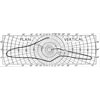
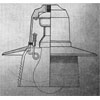 For Group "B" lighting. Introduced in 1946. Believed to be the
ELECO Welwyn.
Construction and lamp accommodation follow closely along the lines of the "Ryde" lantern, but this lantern is
slightly smaller. Top-entry lantern consisting of a one-piece casting in special aluminium alloy having a high
resistance to corrosion. Cast integrally with the body are 3 pairs of lugs to support the lampholder bridge-piece
in the correct focal position for 100, 150 or 200W Metal Filament lamp or 80-125W Mercury Vapour lamps. Lampholder
bridge has slotted ends so that the complete lampholder assembly can be removed from the lantern body by loosening
two retaining screws and releasing by a simple twisting operation. A one-piece dome refractor is attached to the
lantern body by two strong spring clips; a button hook is supplied free with quantities to faciliate
easy and rapid removal of refractor dome during erection and servicing. The lantern is finished in aluminium,
the underside of the reflector being stove enamelled white.
For Group "B" lighting. Introduced in 1946. Believed to be the
ELECO Welwyn.
Construction and lamp accommodation follow closely along the lines of the "Ryde" lantern, but this lantern is
slightly smaller. Top-entry lantern consisting of a one-piece casting in special aluminium alloy having a high
resistance to corrosion. Cast integrally with the body are 3 pairs of lugs to support the lampholder bridge-piece
in the correct focal position for 100, 150 or 200W Metal Filament lamp or 80-125W Mercury Vapour lamps. Lampholder
bridge has slotted ends so that the complete lampholder assembly can be removed from the lantern body by loosening
two retaining screws and releasing by a simple twisting operation. A one-piece dome refractor is attached to the
lantern body by two strong spring clips; a button hook is supplied free with quantities to faciliate
easy and rapid removal of refractor dome during erection and servicing. The lantern is finished in aluminium,
the underside of the reflector being stove enamelled white.
The canopy is made of a special alloy designed to reduce corrosion;
this alloy was demobilised from war service, when it was one of several developed for the
manufacture of deck fittings and the like for warships.
|
|
???
|
100-200W GLS
80-125W MBF/U
|
BC
3BC
|
Top Entry
|
No Gear
|
1946 Advert
1946 Programme
1947 Journal
1947 Advert
1951 Book
|
|

|
ryde
Believed to be the
ELECO Ware.
The lantern body and reflector comprise a one-piece casting of a special aluminium alloy.
A clear outer globe is held in a cast hinged ring with felt gaskets to render the fitting dustproof. Provision is
made for a 16-in. diameter vitreous enamelled reflector if required. A 6-in. diameter single-piece refractor
is firmly secured to the lantern. The standard refractor produces a 170° non-axial distribution. Axial or
symmetrical distribution can be provided if desired.
Pre-set focusing positions exist for the following : 100-watt metal filament, 150-watt metal filament or
80-watt mercury discharge, and 200-watt metal filament or 125-watt mercury discharge lamp.
|
|
???
|
100-200W GLS
80-125W MBF/U
|
BC
3BC
|
Top Entry
|
No Gear
|
1947 Paper
1951 Book
|
|
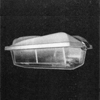
|
so 50
This is the first type of an all-"Perspex"
totally-enclosed refractor street lighting lantern to be produced. The unit consists of a hood,
shaped from 3/16 in. opal "Perspex" and a lower hinged enclosing bowl. Specially designed
"Perspex" refractors are sealed to the sides of the bowl, which is weatherproof when retained
in its "closed" position. The lantern is intended for use with 85 and 140-watt Sodium
Discharge Lamps. The following features are claimed for this lantern:
(1) High optical performance. The "shock-press" method permits the refractors to be made to fine
limits. The lantern has an efficiency of approximately 84 per cent;
(2) Ease of Erection and Maintenance. The lantern slides on to the bracket arm and is fastened by
three readily accessible set screws. There is a special fixing process which prevents the intrusion of dirt;
(3) High Resistance to Corrosion and
(4) Resistance to Mechanical and Thermal Shock
|
|
???
|
85-140W SO/H
|
BC
|
Side Entry
|
No Gear
|
1951 Book
1953 Advert
1953 Advert
1953 Advert
1955 Advert
|
|

|
city
This lantern is suitable either for catenary suspension or pole mounting. The body consists
of a light silicon-aluminium cast framework forming a rigid chassis. Felt gaskets and a deep beading to the roof
render the lantern completely weatherproof. The aluminium reflectors and anti-glare shields can be easily removed,
whilst a one-piece plastic cover protects the lamps, reflectors and shields from dust and damp.
Three 80-watt Metrovick 5-ft. Fluorescent Tubular lamps can be accommodated, with a total output of 6,800 lumens.
All ferrous parts are corrosion-resisting.
|
|
???
|
2 x 80W MCFA/U
3 x 80W MCFA/U
|
4 x BC
6 x BC
|
Side Entry/Catenary
|
Gear
|
1951 Book
|
|
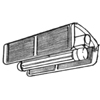
|
|
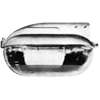
|
|
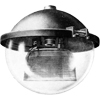
|
|
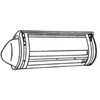
|
|



